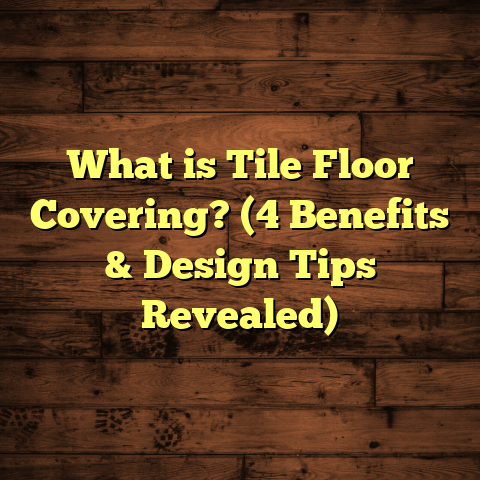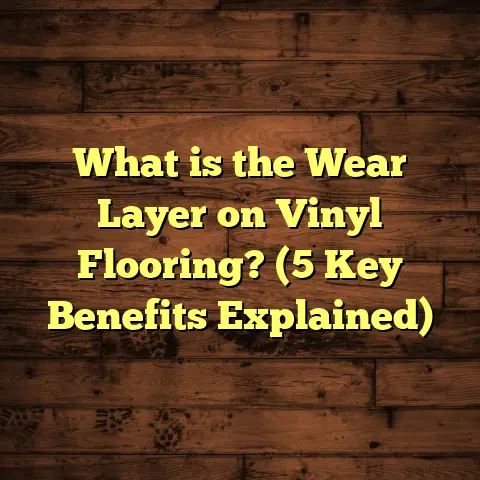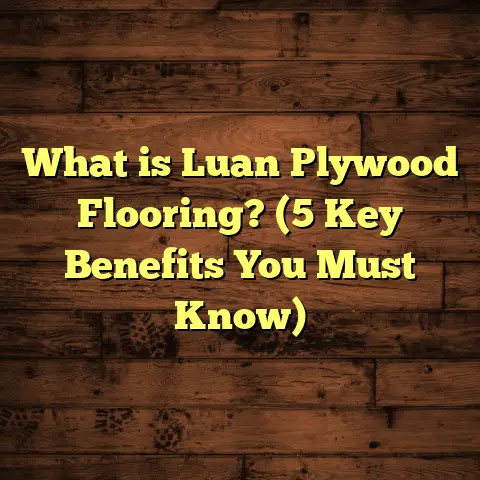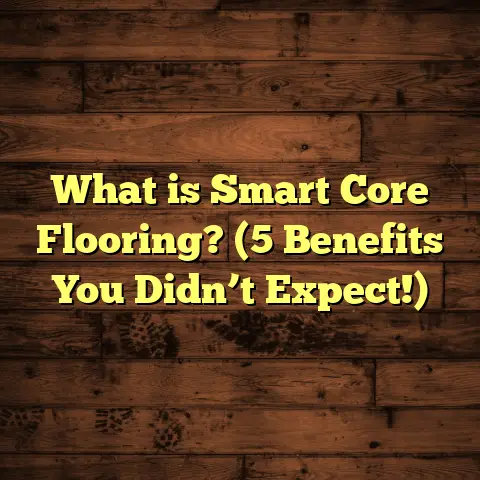What is Rigid Core Flooring Made Of? (5 Materials Explained!)
Have you ever paused while walking across a floor and wondered what exactly is beneath your feet? I ask because rigid core flooring has become so common that many people don’t realize just how much engineering goes into making it tough, stylish, and easy to maintain. After years of installing floors in homes, offices, and even industrial spaces, I’ve gotten curious about what really makes rigid core flooring tick. What’s in the core? Why does it feel different from other vinyl or laminate floors? And how do you pick the right one for your needs?
I’m going to share everything I know about rigid core flooring materials — breaking down the five main types of cores you’ll find on the market. Along the way, I’ll include some real-world examples from my projects, talk about costs and installation times, and even explain how I use tools like FloorTally to nail down pricing and planning.
What Is Rigid Core Flooring?
Let’s start with the basics: What exactly is rigid core flooring?
Rigid core flooring is a type of luxury vinyl flooring that features a solid and stable middle layer—the “core”—which differentiates it from traditional vinyl planks or sheets. This core provides structure and strength, preventing the flooring from bending, warping, or denting under pressure.
Imagine a vinyl plank as a sandwich. The outer layers are what you see and walk on—the decorative vinyl layer printed with wood or stone looks and a transparent wear layer that protects against scratches and stains. The middle layer, or core, is the bread holding everything together. In rigid core flooring, this bread is firm and unyielding.
Here are some key characteristics:
- Durability: Thanks to its solid core, it resists impacts and dents better than flexible vinyl.
- Water Resistance: Most rigid core floors are designed to be highly water-resistant or waterproof.
- Ease of Installation: Usually installed as floating floors with click-lock edges—no glue or nails needed.
- Comfort: Different cores offer varying underfoot feel—from soft and cushioned to firm.
- Sizes: Planks typically measure around 48 inches long by 6 to 9 inches wide.
- Thickness: Varies between 4mm and 8mm depending on product specifications.
Why Is This Important?
I remember a client in Orlando who wanted luxury vinyl for their beach house. They had tried regular vinyl before but complained it felt “spongy” and dented easily. When I introduced them to SPC rigid core flooring, they noticed the difference immediately—the floor felt solid underfoot and held up well against sand and water tracked in from the beach.
From my experience, rigid core flooring tends to last longer than laminate or standard vinyl in areas prone to moisture or heavy traffic. But choosing the right material is essential since the core composition affects performance and price.
The 5 Materials That Make Up Rigid Core Flooring
Now, let me break down the five main materials used for rigid core flooring cores. Each has unique qualities that affect durability, comfort, price, and installation suitability.
1. Wood Plastic Composite (WPC)
Wood Plastic Composite (WPC) is one of the most popular cores for residential use. It blends wood fibers or sawdust with plastic resins to create a composite material that is both strong and somewhat flexible.
Key Features:
| Feature | Specification |
|---|---|
| Thickness | 4-8 mm |
| Density | ~0.9 – 1.1 g/cm³ |
| Cost | $3 – $5 per sq. ft. |
| Water Resistance | High (but not fully waterproof) |
| Underfoot Feel | Softer and warmer compared to SPC |
The wood fibers add some softness underfoot, making WPC feel more comfortable in living rooms or bedrooms than harder cores like SPC.
My Experience with WPC
I installed WPC flooring in several homes in humid Florida areas. While it held up well under normal conditions, one family had a plumbing leak under their kitchen floor that caused some planks to swell after prolonged exposure to water. They needed partial replacement within six months.
This taught me that WPC is durable but not invincible when it comes to standing water or floods. It handles moisture better than laminate but not as well as SPC.
Typical Use Cases
- Living rooms
- Bedrooms
- Moderate foot traffic areas
- Places where warmth underfoot is valued
2. Stone Plastic Composite (SPC)
Stone Plastic Composite (SPC) consists of limestone powder mixed with plastic resins to form a dense, rigid core. It’s heavier and more durable than WPC and almost entirely waterproof.
Key Features:
| Feature | Specification |
|---|---|
| Thickness | 3.5 – 7 mm |
| Density | 1.4 – 1.6 g/cm³ |
| Cost | $4 – $7 per sq. ft. |
| Water Resistance | 100% Waterproof |
| Underfoot Feel | Harder, cooler |
SPC’s density makes it excellent for commercial spaces or wet rooms like bathrooms and kitchens where moisture is a big concern.
Real Project Story
Last year I installed SPC flooring in a busy dental office in Chicago. The floor had to withstand constant foot traffic and frequent cleaning with harsh disinfectants. After 12 months, the floor looked as good as new—no dents, no fading.
The dense limestone composite also helped with sound insulation between floors—a pleasant surprise for the client.
Where SPC Shines
- Bathrooms
- Kitchens
- Commercial areas
- Basements
3. High-Density Fiberboard (HDF)
HDF is mostly used in laminate flooring but sometimes appears in rigid core products. It’s made from wood fibers compressed under high pressure with resin binders.
Key Features:
| Feature | Specification |
|---|---|
| Thickness | 6 – 8 mm |
| Density | ~0.8 g/cm³ |
| Cost | $2 – $4 per sq. ft. |
| Water Resistance | Low (susceptible to swelling) |
| Underfoot Feel | Hard but prone to moisture damage |
HDF feels solid but doesn’t handle moisture well at all.
Personal Experience
I once tried HDF-core flooring in a mountain cabin project in Colorado—an area with snow melt and occasional basement dampness.
Within six months of installation, several planks swelled due to water seepage beneath the floor. They had to be replaced, which was frustrating for everyone involved.
Best Use For
- Dry indoor spaces only
- Rooms with low humidity
- Budget-conscious projects where water risk is minimal
4. PVC Foam Core
PVC foam core uses foamed polyvinyl chloride as the middle layer. This makes the planks lightweight yet stable.
Key Features:
| Feature | Specification |
|---|---|
| Thickness | 5 – 7 mm |
| Density | 0.4 – 0.6 g/cm³ |
| Cost | $4 – $6 per sq. ft. |
| Water Resistance | Excellent |
| Underfoot Feel | Soft and cushioned |
The foam gives some added comfort while maintaining good stability and moisture resistance.
When I Recommend PVC Foam Core
For landlords or clients who want quick DIY installations in rental properties or low-use rooms, PVC foam core floors are great because they’re easier to cut and lighter to carry around.
I installed these in a multi-unit rental property in Seattle where tenants frequently moved in and out. The floors held up well for over two years with minimal wear despite heavy use.
5. Aluminum Composite Core
This one is rare but fascinating—a metal core wrapped with vinyl layers creates an ultra-rigid plank.
Key Features:
| Feature | Specification |
|---|---|
| Thickness | Varies (often thinner due to metal strength) |
| Density | High (due to aluminum) |
| Cost | $6 – $10 per sq. ft. |
| Water Resistance | Waterproof |
| Underfoot Feel | Very hard, cold |
It’s not common for residential use but excellent for industrial spaces requiring extreme impact resistance.
Industrial Application Example
A client running an automotive workshop requested this flooring because they needed something resistant to dropped tools, chemicals, and heavy machinery movement.
The aluminum composite core lasted over three years without damage—far beyond their previous floors’ lifespan.
Comparing the Materials: Which One Should You Pick?
Here’s a quick comparison table I often refer to when advising clients:
| Core Material | Durability | Water Resistance | Comfort | Cost Range (Material) | Best Use |
|---|---|---|---|---|---|
| WPC | Medium | High | Soft | $3-$5/sq.ft | Residential living spaces |
| SPC | High | Waterproof | Firm | $4-$7/sq.ft | Bathrooms, kitchens, commercial |
| HDF | Low | Low | Firm | $2-$4/sq.ft | Dry areas only |
| PVC Foam Core | Medium | Excellent | Soft | $4-$6/sq.ft | DIY installs, rentals |
| Aluminum Composite | Very High | Waterproof | Very Firm | $6-$10/sq.ft | Industrial/high-impact areas |
Installation Timeframes & Costs
Based on my hands-on work in different states—including California, Texas, New York—I can share typical timeframes and costs for rigid core flooring installation:
- Average room size: ~200 sq.ft
- Installation time: 1-3 days depending on prep work (removing old floor, leveling)
- Material cost: $3-$10 per sq.ft depending on core material and brand
- Labor cost: $2-$5 per sq.ft varies by region
- Total cost: $6-$15 per sq.ft including materials & labor
For example:
- A WPC floor in Austin might run about $7 per sq.ft total.
- An SPC commercial job in New York City could hit $12-$15 per sq.ft due to higher labor rates.
I always recommend clients budget for an extra 5%-10% material waste due to cutting around corners or odd room shapes.
How FloorTally Helps Me Manage Costs & Planning
Estimating costs accurately is crucial—and that’s where FloorTally comes in handy for me.
Instead of juggling multiple spreadsheets or calling vendors for quotes:
- I input room dimensions.
- Select product type (WPC/SPC etc.).
- Enter local zip code for labor cost estimates.
- Adjust waste factors based on layout complexity.
FloorTally gives me a detailed cost breakdown—materials vs labor vs extras—that I can share with clients transparently.
This tool saved me weeks of back-and-forth on recent projects where clients wanted realistic budgets upfront before ordering materials.
Maintenance Tips Based on Core Material
Maintaining rigid core flooring depends partly on the material inside:
- WPC: Clean spills quickly; avoid standing water; use mild cleaners.
- SPC: Very low maintenance; can handle wet mopping; avoid abrasive scrubbing.
- HDF: Avoid water at all costs; dry clean preferred.
- PVC Foam: Regular sweeping; quick clean spills.
- Aluminum Composite: Use non-corrosive cleaners; avoid metal scratches.
I always tell my clients that while these floors are tough, treating them well extends their lifespan dramatically.
Troubleshooting Common Issues
Even the best floors can have problems:
- Buckling or gaps: Often caused by improper acclimation before install or insufficient expansion space.
- Swelling: Usually due to moisture exposure—especially with WPC or HDF cores.
- Scratches/dents: Heavy furniture without pads can damage softer cores like WPC.
I’ve seen buckling in homes where installers skipped the recommended expansion gap of 1/4 inch around edges during installation—lesson learned!
Final Words on Rigid Core Flooring Materials
Choosing rigid core flooring means balancing durability, budget, comfort, and moisture concerns based on your space’s needs.
From my experience:
- SPC offers unbeatable toughness for wet or commercial areas.
- WPC brings warmth and comfort ideal for homes.
- Avoid HDF if moisture is possible.
- PVC foam cores fit light-use or rental properties.
- Aluminum composite cores suit industrial settings only.
If you’re planning a project soon, reach out anytime—I’m happy to help you pick the right material based on your lifestyle, budget, and local conditions!
If you want me to add even deeper dives into specific brands or installation methods next, just say so!





